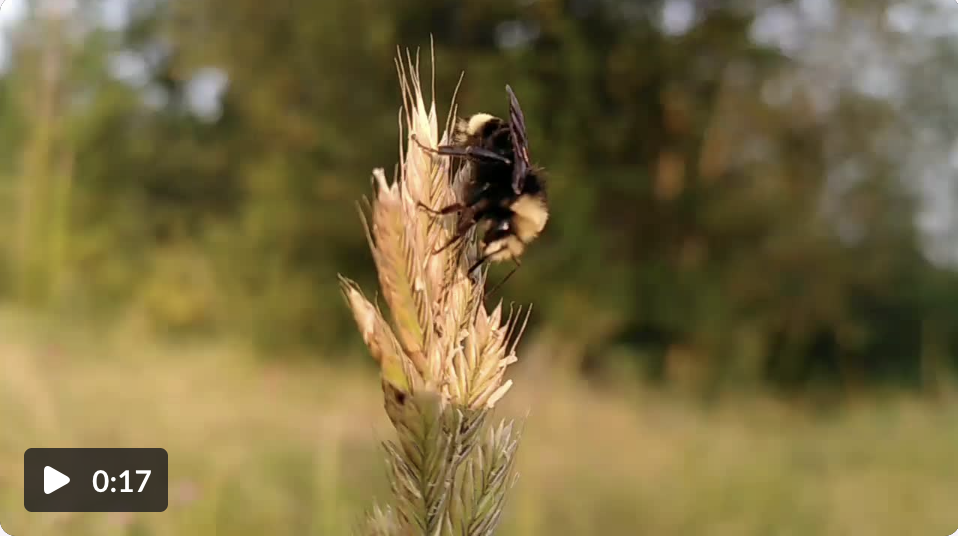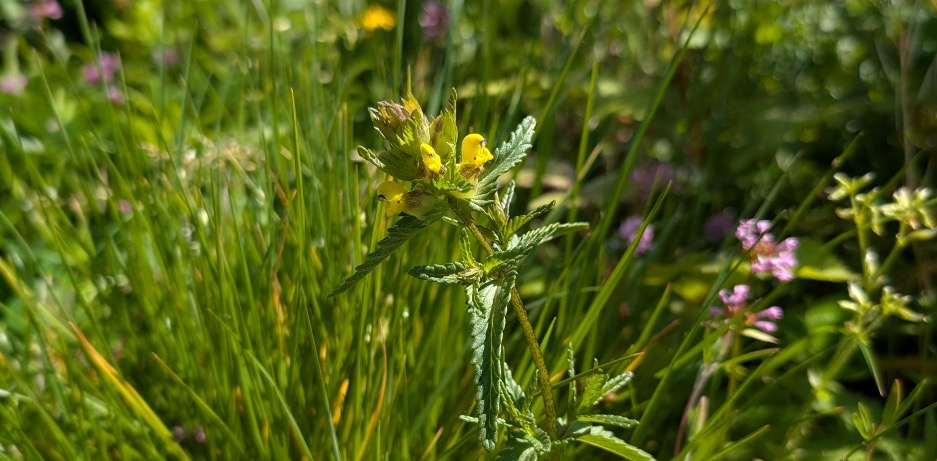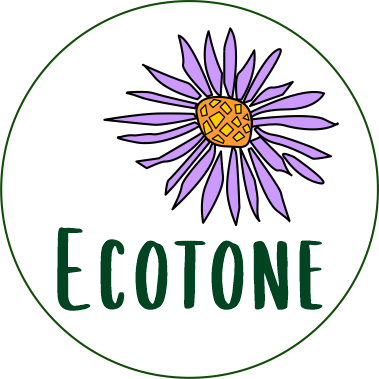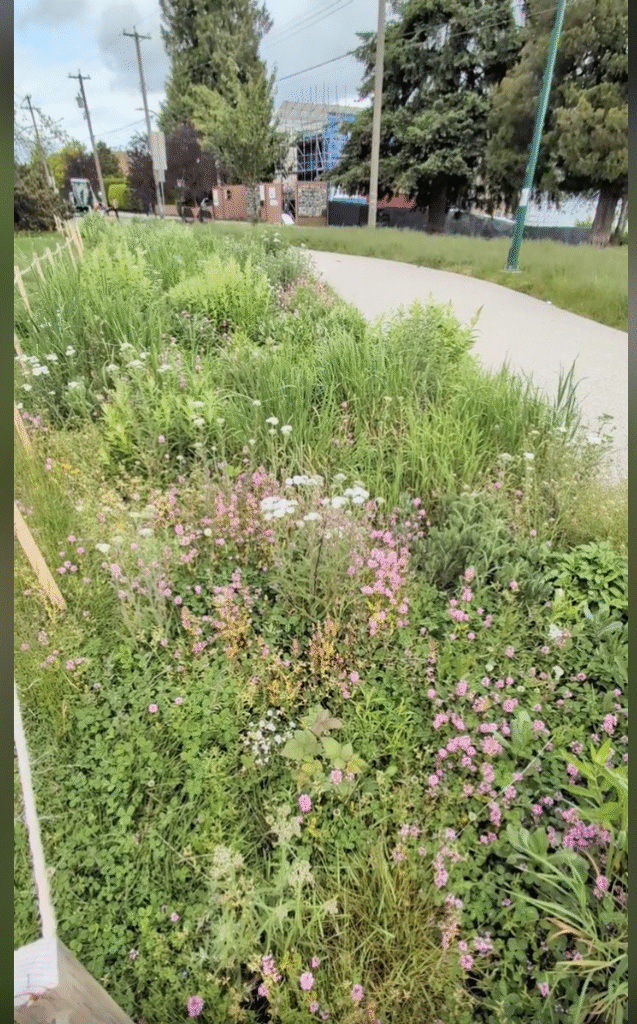The air is full of grass pollen: it’s sneeze season, whether or not you have allergies! In this educational post, our lead ecologist, Dr. Christine Thuring, shares the beauty of grasses, with some tips on grass identification. We also introduce the “meadow maker”, yellow rattle, a hemiparasitic forb that challenges grass dominance.

From spring through summer, the sound of sneezing resounds across much of the Northern hemisphere. Whether or not you have allergies, few can resist reacting to the extreme pollen load of wind-pollinated plants , notably grasses and trees (especially birch, alder, and hazel). (Note that flowering herbs do NOT cause allergies! Sneezeweed is named for its historical use as a snuff.)
Love grass: Beauty and bees
As a plant ecologist, I love plants. While this love includes grasses (to the point of taking selfies with them), grass ID is not my favourite thing. That said, I learned some tricks of the trade for field identification, which you’ll find further down this post. Since grass flowers are often overlooked, let’s start with their beauty, how to know them, and consider how grasses benefit wild bees.

Our native beach grass (Leymus mollis) is grey-green, and grows tall and erect, often in large tussocks or clumps on sandy beaches and dunes. Its roots are stimulated by shifting sand, making it a perfect dune stabilizer.
Grasses and Beauty
Grasses are flowering plants. Their flowers are not showy, however, as their pollen is carried by the wind and they don’t need to attract pollinators Regardless, if you take the time to examine them closely, the flowers of grasses are quite beautiful. (Find more nice pictures of grass flowers here).

Just like other flowering plants, grasses have particular flowering periods. In BC, we have cool-season or warm-season grasses. Cool-season grasses, which emerge earlier in spring, tend to flower in early summer, while warm-season grasses typically bloom in late summer or early autumn.
Grasses and Bees
While visiting Ojibway Prairie in southern Ontario a few years ago, I snapped a picture of big bluestem (Andropogon gerardii) in flower. This photo ended up becoming the top image for Ecotone’s home page, because it surreptitiously captured a bee coming in for a landing. Amazing! 
In addition to ebullient joy, the image raised questions:
- What relationship do grasses have with bees (and vice versa)?
- What was the bee coming for?
- How do bees use grasses?
We’ve since learned that, while bees may use grasses for perching or resting, they generally do not use grasses for forage. Naturally, there are no hard and fast rules in ecology. Some grasses may exude liquid that contain sugars, which bees and other insects will consume. When I noticed a bumblebee perched on a grass inflorescence for quite some time, I wondered what the bee was doing, and whether they enjoy grass pollen. 
To these questions, my bee expert colleague, Lincoln Best, replied, “It’s a boy. He never extended his mouthparts. Maybe he was perching, using an elevated position to look for females or competing males. Or maybe just resting.”
To the question how bees relate to grasses, it appears that nesting is more important than forage, if indirectly. Most wild bees live in the ground, so they benefit from grasses that leave some soil exposed, like bunch grasses. For instance, fine fescue lawns mixed with native or non-invasive flowering plants provide the best habitat for both nesting and foraging. For bee-friendly lawns, native species of fescue (Festuca spp.) are great because:
- they are low-growing, tolerant of mowing, and require less fertilizer and irrigation
- they allow for the integration of flowering forbs, which are essential for bee forage
- their growth habit creates open patches and loose soil, which is favorable for ground-nesting bees
Native bunchgrasses, like Idaho fescue (Festuca idahoensis), may also provide suitable habitat structure, especially in natural or restoration settings, by maintaining open ground and supporting a diversity of wildflowers. Bunchgrasses also produce thatch and litter at their base, which is easily cleared away to reveal open soil.
If you want to support native bees in your yard, consider this range of lawn options, in order of least ideal to optimal:
| Least ideal | Mowed, non-native grass lawn |
| Decent (not ideal) | Patchy, flowering weedy lawn |
| Ideal | Native wildflower meadow |
| Optimal/ best | Native wildflowers, hedgerow plantings, and provision of broken, overwintered stems as well as brush piles, decaying logs, exposed sandy soil patches |
Meadow maker: Yellow rattle as antidote to grass dominance
Competitive grasses are problematic for all meadows and lawn conversions. The fact is that grass dominance over wildflowers is often a symptom of soil nutrient conditions and plant selection. Species-rich meadows typically occur on nutrient-poor soils, which don’t favour competitive grasses. The meadow below is diverse because of the low-nutrient soil. Note the orchid (Orchis spp), quaking grass (Briza spp), kidney vetch (Lotus spp) surrounded by yellow rattle (Rhinanthus spp). This meadow complex supports 175 plant species, including 9 orchids.

There are many methods and strategies to keep grasses in check. One neat method is a semi-parasitic annual wildflower, yellow rattle (Rhinanthus spp). This plant suppresses grass growth and vigour by parasitizing their roots. In Europe, this relationship has been understood for centuries, and yellow rattle is also referred to as “meadow maker”. Although Rhinanthus minor is native to BC, nobody seems to know this. Could it be that the rapid colonization of People and ecosystems in the Pacific Northwest obviated both collective and individual understanding about this species and its role here? Could restoring yellow rattle here, as a meadow maker, serve to decolonize the land (and people)?

Note the prevalence of Rhinanthus in this Swiss meadow. Flowering and a robust appearance indicates that yellow rattle is successfully attached to the roots of a grass host. Apparently they flower when unattached, but are less vigorous.
Case study: Pollinator Meadow at Trutch and West Point Grey
I decided to test out our native species of yellow rattle at “my” pollinator meadow at Trutch and West Point Grey Road. Like many native plants, the seeds must be sown onto soil in autumn (September or October), ensuring seeds make contact with bare soil for successful germination. Since we couldn’t find a supply in BC, we sourced yellow rattle seed from Northwest Meadowscapes (Port Townsend, WA). In January 2025, we laid some seed in the wildflower meadow at West Point Grey Road and Trutch, and were pleased to find a few specimens flowering in the latter half of May.

Since this meadow was installed on fresh, clean soil, it is free from weedy grasses. Instead, it features some truly fantastic native grasses. California brome (Bromus carinatus) is featured in the video below (from the last week of May). Also present are tufted hair grass (Deschampsia cespitosa) and Roemer’s fescue (Festuca roemeri). These species are all bunchgrasses, which came integrated as part of the Coastal Blend seedmix (from Satinflower Nurseries). We’ll be observing the yellow rattle with interest!
Tips on Grass ID
We promised some tips on grass identification. Before anything, it should be clarified that the big challenges to identifying grasses are terminology and access to magnification. The organs essential to this ID tip center around the spikelet, a flowering unit comprised of one or more florets enclosed by two glumes (bracts). Depending on how the spikelet is attached to the rachis, grass inflorescences can be described in certain ways (e.g., a spike, raceme, panicle).

Image courtesy of Oregon State University.
While doing field surveys for my PhD in Germany, I learned a quick and easy tip for identifying grasses to genus. I believe it was Prof. Dr. Reinhard Böcker, from the University of Hohenheim who shared this with me. I’ve not seen this anywhere else, so take it with a grain of salt (or of pollen!).
Referring to the grass inflorescence, first find the lowest spikelet, and then count how many branches come out of the bottom axil of that spikelet. As per the table below, you can now narrow it down to four genera of grasses (Festuca, Poa, Deschampsia, Agrostis). Given there are around 500 genera of grasses in BC, this is not a silver bullet. The key tip here is learning how/ what to look for.

I hope you have learned something useful with this post. If you suffer from pollen allergies, keep taking those anti-histamines. If you want to do something good, consider asking your municipality to replace grass with species-rich wildflower meadows! If you’re really motivated to make this happen, consider joining the Bee City Canada movement. Lastly, if you’re a designer, creator or maintainer of meadows, consider experimenting with yellow rattle and low-nutrient soils. Contact us for guidance, support, and/ or let’s collaborate.

If you made it this far, bravo! We’d love to hear your thoughts, so please use the Comments below.

